Biology > Quiz > BIOL 181 - Week 2 Quiz (100% CORRECT) Questions and Answers | American Public University (All)
BIOL 181 - Week 2 Quiz (100% CORRECT) Questions and Answers | American Public University
Document Content and Description Below
Question 1 of 33 3.0/ 3.0 Points The following are all levels of the structural organization of the human body: 1. Organ 2. Organ system 3. Tissue 4. Cell 5. Chemical level Arrange the above level... s from least complex to most complex: A. 3, 4, 1, 2, 5 B. 1, 2, 3, 4, 5 C. 5, 4, 3, 1, 2 D. 5, 4, 6, 2, 1 E. 4, 5, 1, 2, 3 Feedback:Good work; your answer is correct! Question 2 of 33 3.0 / 3.0 Points Which of the following are considered primary requirements of life for a multi-celled organism? A. Oxygen B. Water and other nutrients C. A controlled temperature in which to live D. A narrow range of atmospheric pressure E. All the above are primary requirements of life for a multi-celled organism. Feedback:Good work; your answer is correct! Question 3 of 33 3.0 / 3.0 Points Almost all of the liver of a human being is located in which abdominopelvic quadrant? A. Left upper quadrant (LUQ) B. Right lower quadrant (RLQ) C. Epigastric quadrant D. Left lower quadrant (LLQ) E. Right upper quadrant (RUQ) Feedback:Good work; your answer is correct! Question 4 of 33 0.0 / 3.0 Points Which of the following statement(s) is(are) correct? A. Anabolism is a process in which complex structures or molecules are broken down into much simpler ones. B. Catabolism is a process in which simple molecules can be combined to form more complex molecules or tissues. C. Metabolism is the sum of all anabolic and catabolic reactions that take place in the body. D. A waste product of all the reactions that take place in a cell is the molecule ATP. E. All of the above statements are correct. Feedback:Metabolism is the sum of all anabolic and catabolic reactions that take place in the body. A process in which complex molecules are broken down is called catabolism; anabolism is a process in which simple molecules are chemically combined into more complex molecules. The molecule ATP is the most important molecule in which energy is stored and then made usable for reactions inside each cell of the body. Question 5 of 33 3.0/ 3.0 Points The smallest independently functioning unit of a living organism is a(an): A. atom B. cell C. organ D. molecule E. tissue Feedback:Good work; your answer is correct! Question 6 of 33 3.0 / 3.0 Points The ability of an organism to adjust to changes in either its internal or external environments is called . A. movement B. development C. responsiveness D. growth E. homeostasis Feedback:Good work; your answer is correct! Question 7 of 33 3.0/ 3.0 Points What is the position of the body when it is in the “normal anatomical position?” A. The person is standing facing the observer, with upper limbs extended straight up and lower limbs close together. B. The person is prone with upper limbs, including palms, touching sides and lower limbs touching at sides. C. The person is standing facing the observer, with upper limbs extended down and palms of both hands facing forward and with the lower limbs close together with toes pointing straight forward. D. The person is standing facing the observer, with upper limbs extended out at a ninety-degree angle from the torso and lower limbs in a wide stance with feet pointing laterally. E. The person is supine with upper limbs, including palms, touching sides and lower limbs touching at sides. Feedback:Good work; your answer is correct! Question 8 of 33 3.0 / 3.0 Points Which of the following statement(s) is(are) correct? A. Regional anatomy is the study of the interrelationships of all of the structures in a specific body region B. Systemic anatomy is the study of the structures that make up a discrete body system. C. Your study of anatomy and physiology will make more sense if you continually relate the form of the structures you are studying to their function. D. Like most scientific disciplines, anatomy has areas of specialization. E. All of the above statements are true. Feedback:Good work; your answer is correct! Part 2 of 7 - 21.0/ 24.0 Points Question 9 of 33 3.0/ 3.0 Points Which of the following is NOT a difference between DNA and RNA? A. DNA contains alternating sugar-phosphate molecules whereas RNA does not contain sugars B. DNA contains thymine whereas RNA contains uracil C. DNA contains deoxyribose and RNA contains ribose D. They have completely different functions. E. RNA is single stranded and DNA is double stranded Feedback:Good work; your answer is correct! Question 10 of 33 3.0/ 3.0 Points How many bases found on a gene translate for any one amino acid? A. One B. Two C. Three D. Four E. Five Feedback:Good work; your answer is correct! Question 11 of 33 3.0 / 3.0 Points The cell membrane (also called the plasma membrane) contains which of the following molecules? A. proteins B. cholesterol C. phospholipids D. glycoproteins E. All of the above Feedback:Good work; your answer is correct! Question 12 of 33 3.0 / 3.0 Points The molecules which store the genetic instructions of an organism is . A. ATP B. Histone C. RNA D. ADP E. DNA Feedback:Good work; your answer is correct! Question 13 of 33 3.0/ 3.0 Points Because of their unique molecular structures, only the following bases found in DNA can bind together: A. A to T B. T to A C. C to G D. G to C E. All of the above Feedback:Good work; your answer is correct! Question 14 of 33 3.0/ 3.0 Points Which of these methods that aids in the movement of ions or molecules across a cell membrane requires the use of energy which is supplied by ATP molecules? A. Active transport B. Reverse diffusion C. Facilitated diffusion D. Osmosis E. Passive transport Feedback:Good work; your answer is correct! Question 15 of 33 3.0 / 3.0 Points What scientist is given credit for coming up with the concept of the cell? A. Galileo B. Michael Curie C. Robert Hooke D. Albert Einstein E. Michelangelo Feedback:Good work; your answer is correct! Question 16 of 33 0.0 / 3.0 Points The most direct method by which an ion or molecule can move across a cell membrane is by . A. a sodium-potassium pump B. simple diffusion C. active transport D. using an integral protein E. osmosis Feedback:Simple diffusion is a means that uses the natural kinetic energy of an ion or molecule as well as a simple difference in concentration to allow the movement of that ion or molecule. Part 3 of 7 - 15.0/ 18.0 Points Question 17 of 33 3.0 / 3.0 Points muscle is not voluntary and is responsible for the involuntary movements of internal organs such as the esophagus. A. Stratified B. Columnar C. Skeletal D. Smooth E. Cardiac Feedback:Good work; your answer is correct! Question 18 of 33 3.0/ 3.0 Points Cells of the body are organized into broad categories of tissue. A. two B. five C. four D. six E. three Feedback:Good work; your answer is correct! Question 19 of 33 0.0/ 3.0 Points The embryonic tissue level, mesoderm, gives rise to which of the following type(s) of tissue? A. Skin cells B. Neurons C. Skeletal muscle D. Thyroid cells E. All of the above Feedback:The mesoderm gives rise to all types of muscle tissue, tubule cells of the kidney, and red blood cells. Question 20 of 33 3.0/ 3.0 Points The following types of tissue all are part of the category named muscle tissue: A. Skeletal muscle B. Smooth muscle C. Cardiac muscle D. Visceral muscle E. A, B, and C are all correct. Feedback:Good work; your answer is correct! Question 21 of 33 3.0/ 3.0 Points The different types of cells are not randomly distributed throughout the body; rather they occur in organized layers, a level of organization referred to as . A. epithelial B. tissue C. an organ system D. an organ E. a cell system Feedback:Good work; your answer is correct! Question 22 of 33 3.0 / 3.0 Points The of a neuron receive impulses from other neurons; the transmits nerve impulses to other cells. A. Dendrites; axon B. Axon; dendrites C. Soma; axon D. Soma; dendrites E. None of these pairs are correct. Feedback:Good work; your answer is correct! Part 4 of 7 - 12.0/ 15.0 Points Question 23 of 33 3.0 / 3.0 Points Which of the following cells are primarily responsible for producing the pigment that gives color to the skin? A. Melanocytes B. Merkel cells C. Keratinocytes D. Langerhans cells E. Basal cells Feedback:Good work; your answer is correct! Question 24 of 33 3.0 / 3.0 Points Which of the following layers contain blood vessels? A. Stratum corneum B. Stratum basale C. Stratum granulosum D. Papillary dermis E. None of the above Feedback:Good work; your answer is correct! Question 25 of 33 3.0 / 3.0 Points What is the largest organ of the body? A. Liver B. Uterus C. Skin D. Heart E. Brain Feedback:Good work; your answer is correct! Question 26 of 33 0.0 / 3.0 Points Which of the following skin conditions results from long-term, unrelieved pressure over certain body parts that are bony, leading to death of the overlying tissue? A. Decubitus ulcer B. Bedsore C. Corn D. Keloid E. Two of the above Feedback:Decubitus ulcers, otherwise known as bedsores, typically result when pressure is not relieved over body areas of the skin, cutting of blood supply, inevitably causing necrosis to the tissue. Question 27 of 33 3.0 / 3.0 Points The cuticle of the nail is also known as the . A. Eponychium B. Lunula C. Hyponychium D. Perinychium E. None of the above Feedback:Good work; your answer is correct! Part 5 of 7 - 6.0/ 6.0 Points Question 28 of 33 3.0/ 3.0 Points Glands are considered which type of tissue? A. muscle B. epithelial C. nervous D. connective Feedback:Correct. Good job! Question 29 of 33 3.0 / 3.0 Points How do neurotransmitters move from one neuron to another across a synapse? A. bulk-phase endocytosis B. active transport C. exocytosis D. phagocytosis Feedback:Correct. Good job! Part 6 of 7 - 6.0/ 9.0 Points Question 30 of 33 0.0 / 3.0 Points Why did scientists put shrimp on a treadmill? A. To measure free radicals affecting crustaceans B. To determine how fast crustaceans can run C. To provide therapy to injured crustaceans D. To educate the public about pollution E. To compare data to human “stress tests” Feedback:Understanding how crustaceans are impacted by poor water quality caused by human contamination was the basis for this study. Review the section titled “Case Study: Why Did We Put Shrimp on a Treadmill” in the Week 2 Lab ELF Lesson. Question 31 of 33 3.0/ 3.0 Points Which of the following is considered a secondary source of research? A. Lab notebooks B. Published books C. Conference papers D. Peer-reviewed journals E. Theses compositions Feedback: Correct! Secondary research is considered original work that has been interpreted or evaluated by a second party. Question 32 of 33 3.0 / 3.0 Points What should be included when designing a scientific question? A. It should repeat the work of another researcher B. It should be very general C. It should be based on bias D. It should be based on moral or legal issues E. It should be based on background research Feedback:Correct! Scientific questions should be specific enough to help design a good hypothesis and should be based on facts, testable, and verifiable. Part 7 of 7 - Part 7 - 1 Question 4 points 4.0/ 4.0 Points Question 33 of 33 4.0/ 4.0 Points The largest and most prominent of a cell’s organelles is its . A. nucleus B. nucleolus C. mitochondrion D. ribosome E. Golgi apparatus Feedback:Good work; your answer is correct! [Show More]
Last updated: 1 year ago
Preview 1 out of 14 pages

Reviews( 0 )
Document information
Connected school, study & course
About the document
Uploaded On
Aug 24, 2022
Number of pages
14
Written in
Additional information
This document has been written for:
Uploaded
Aug 24, 2022
Downloads
0
Views
43

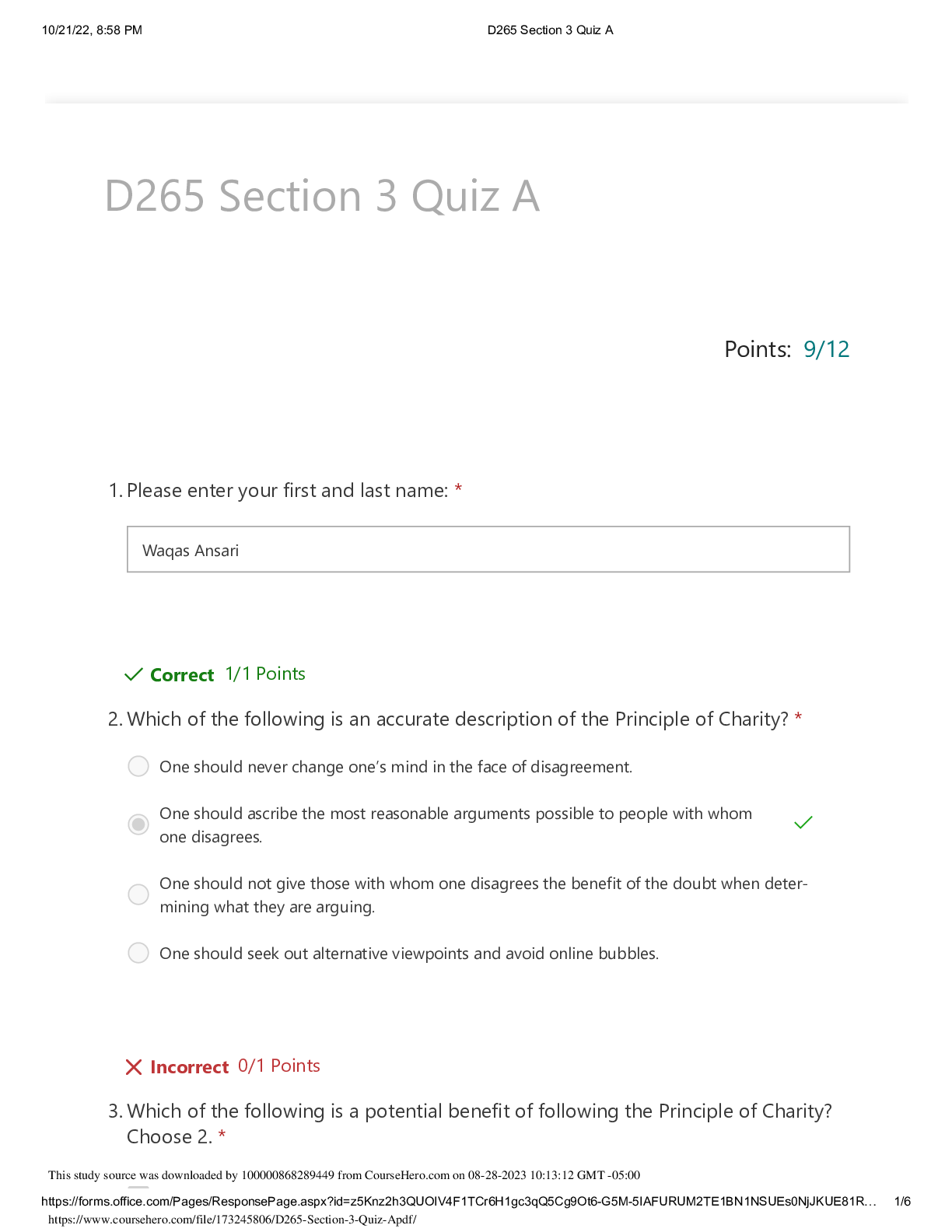
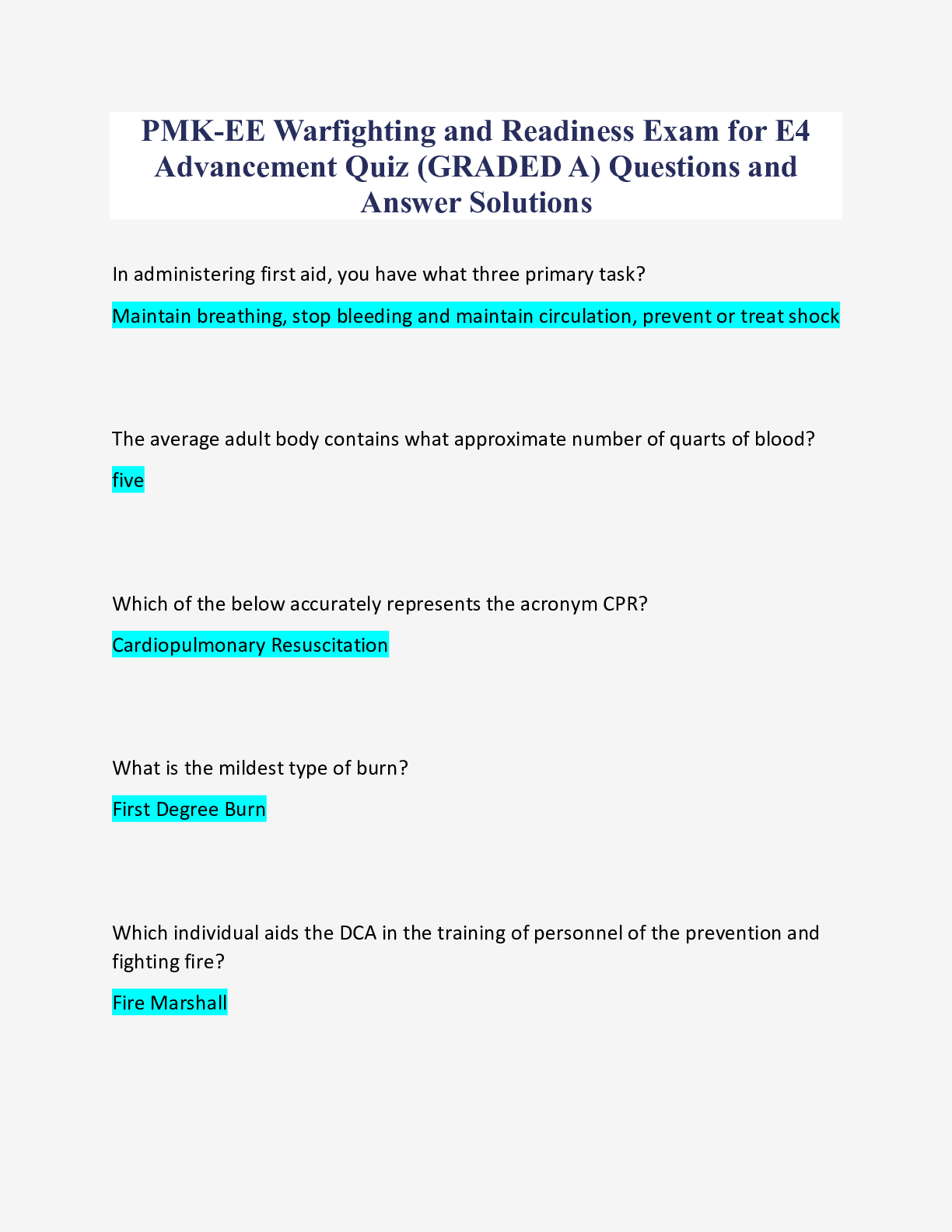

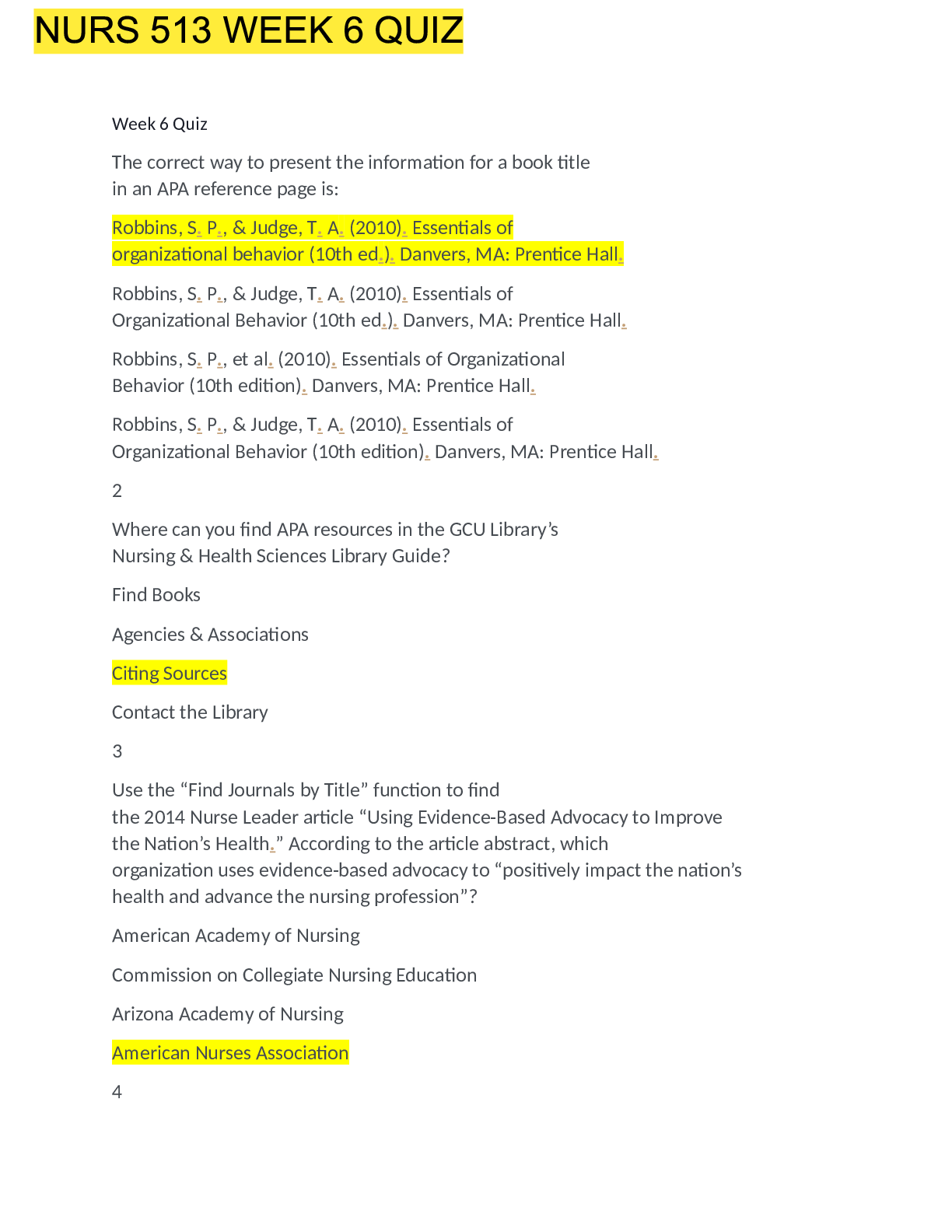


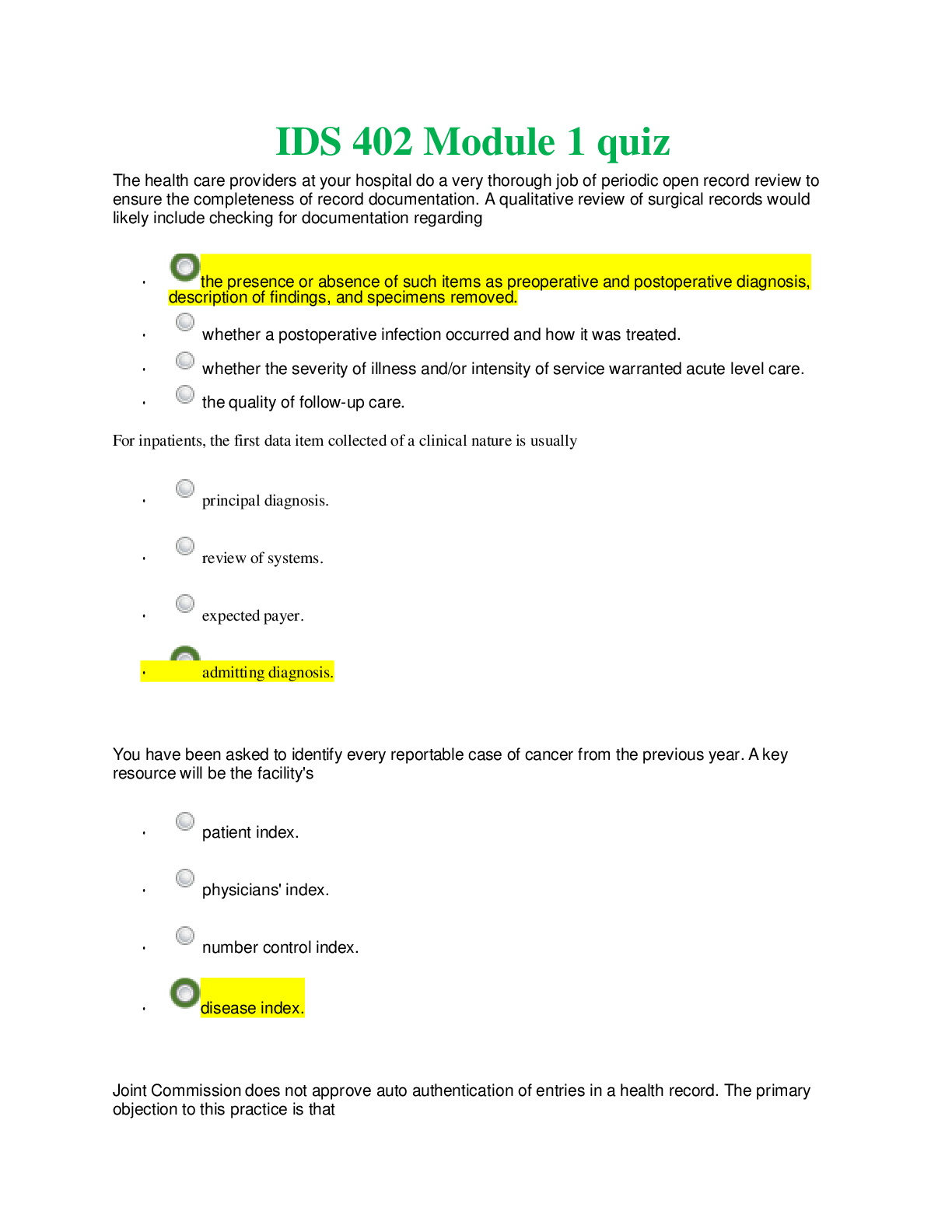


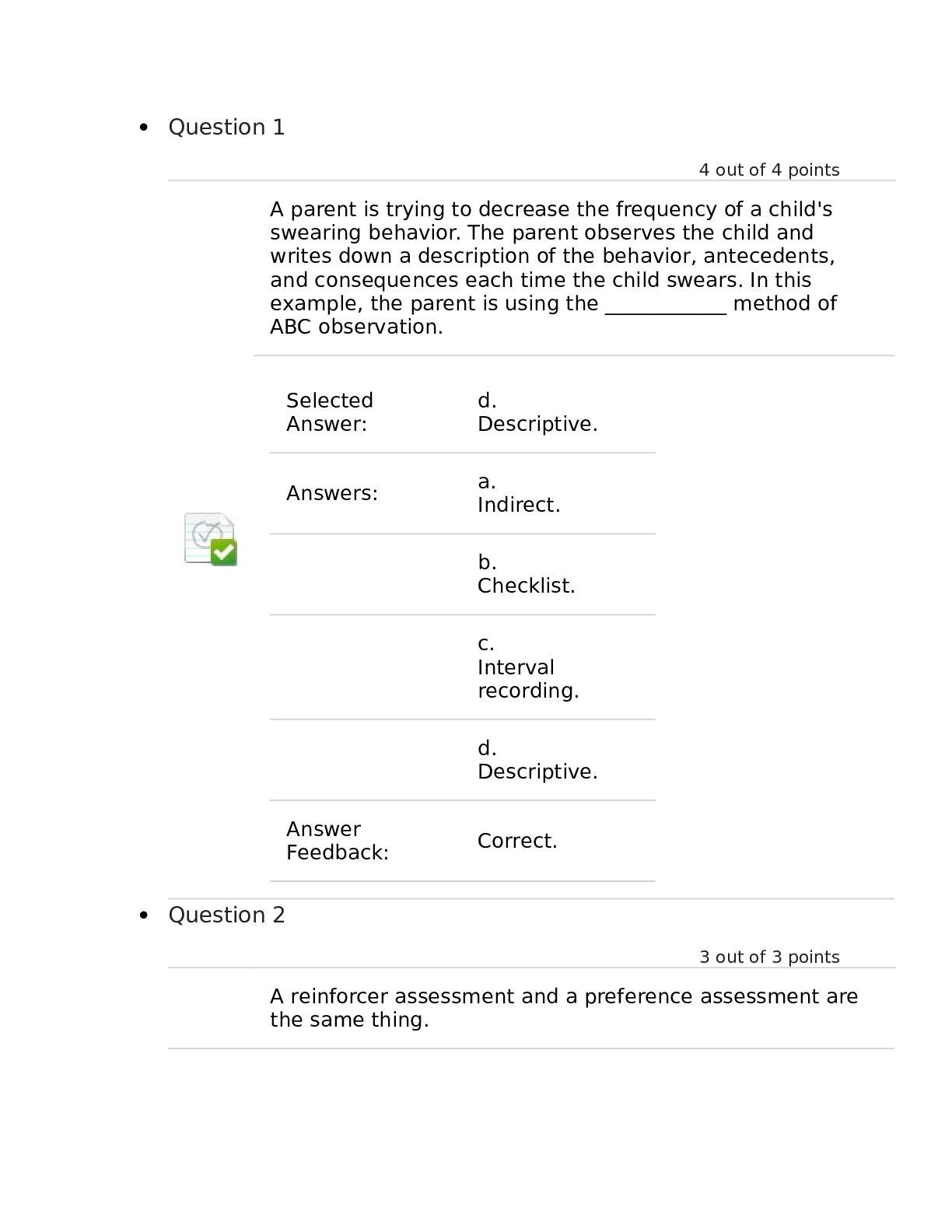
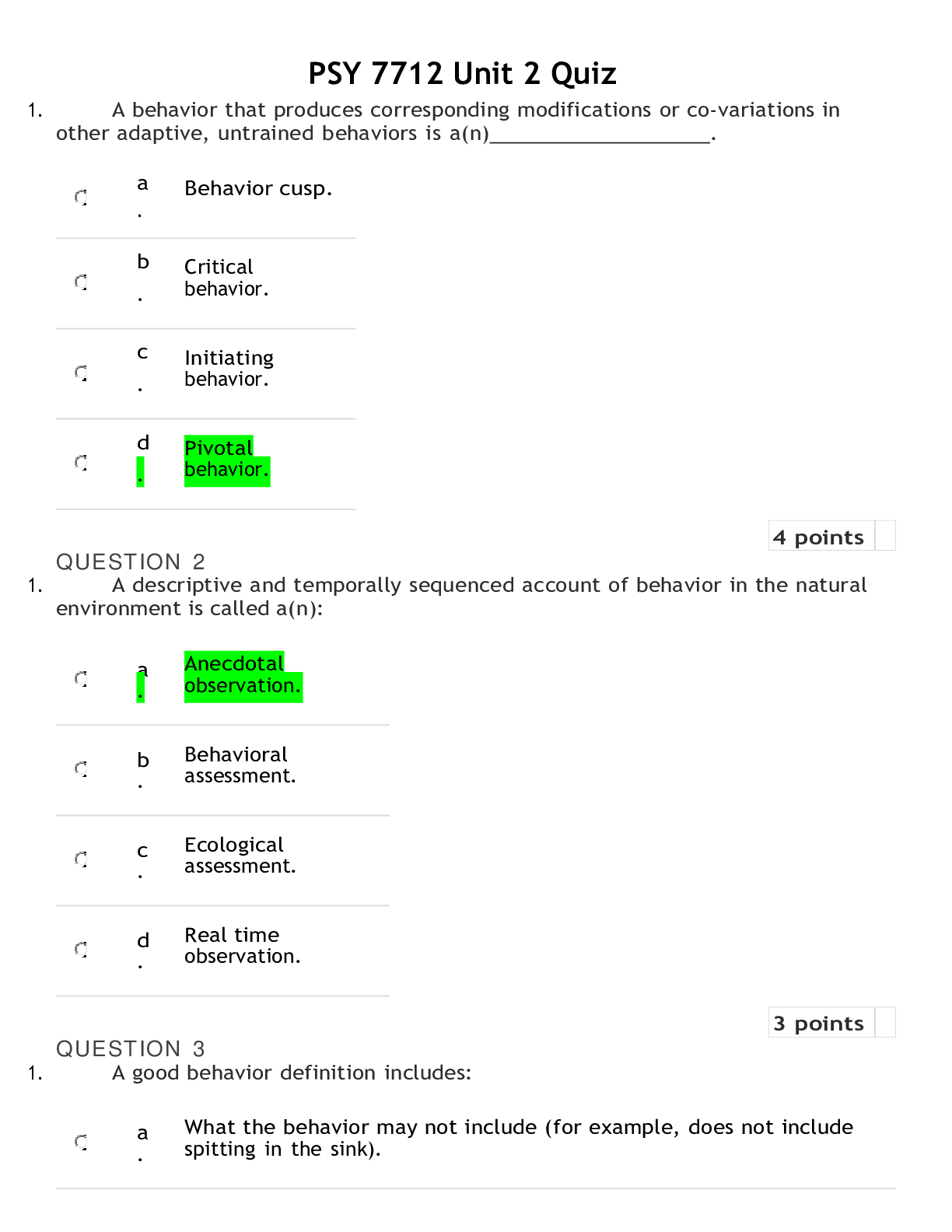


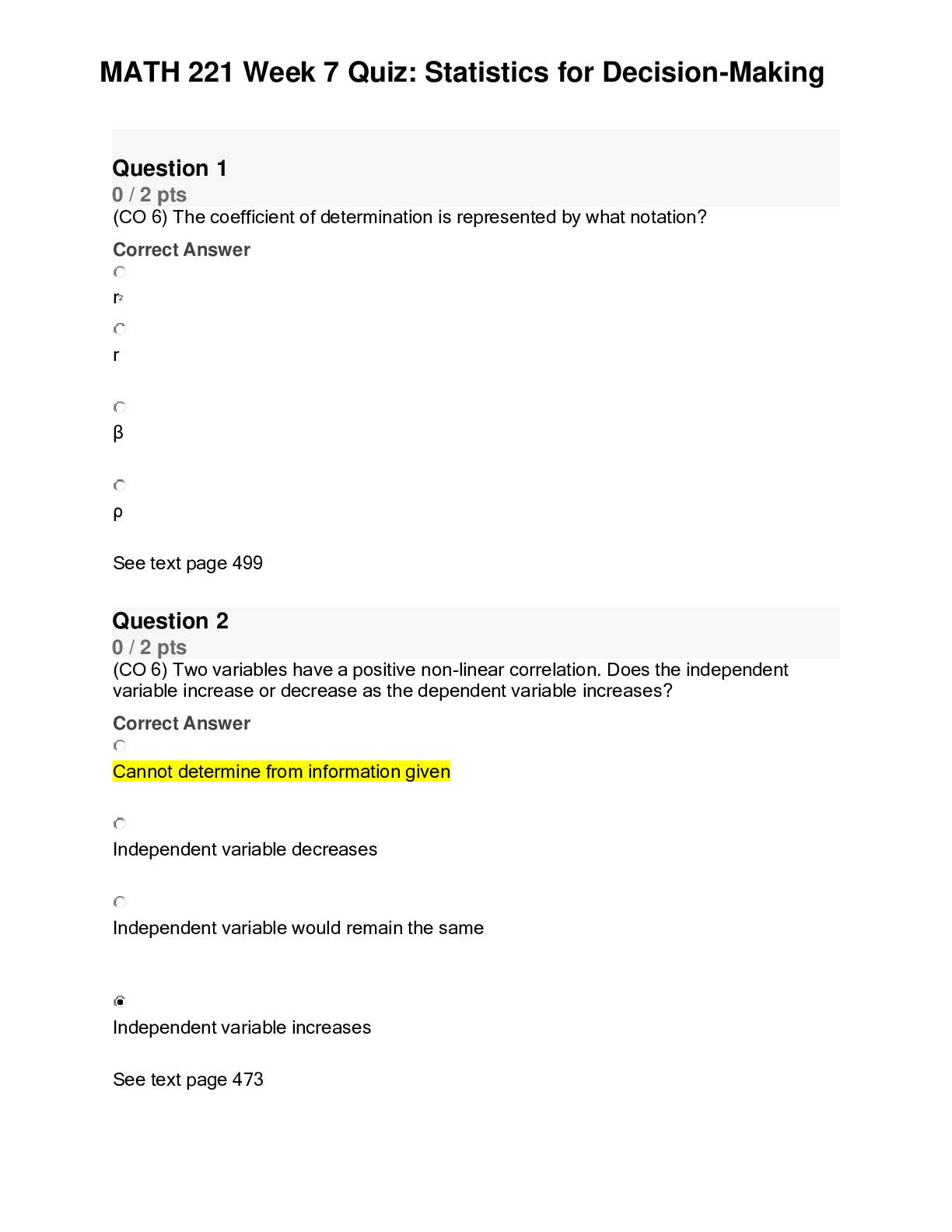
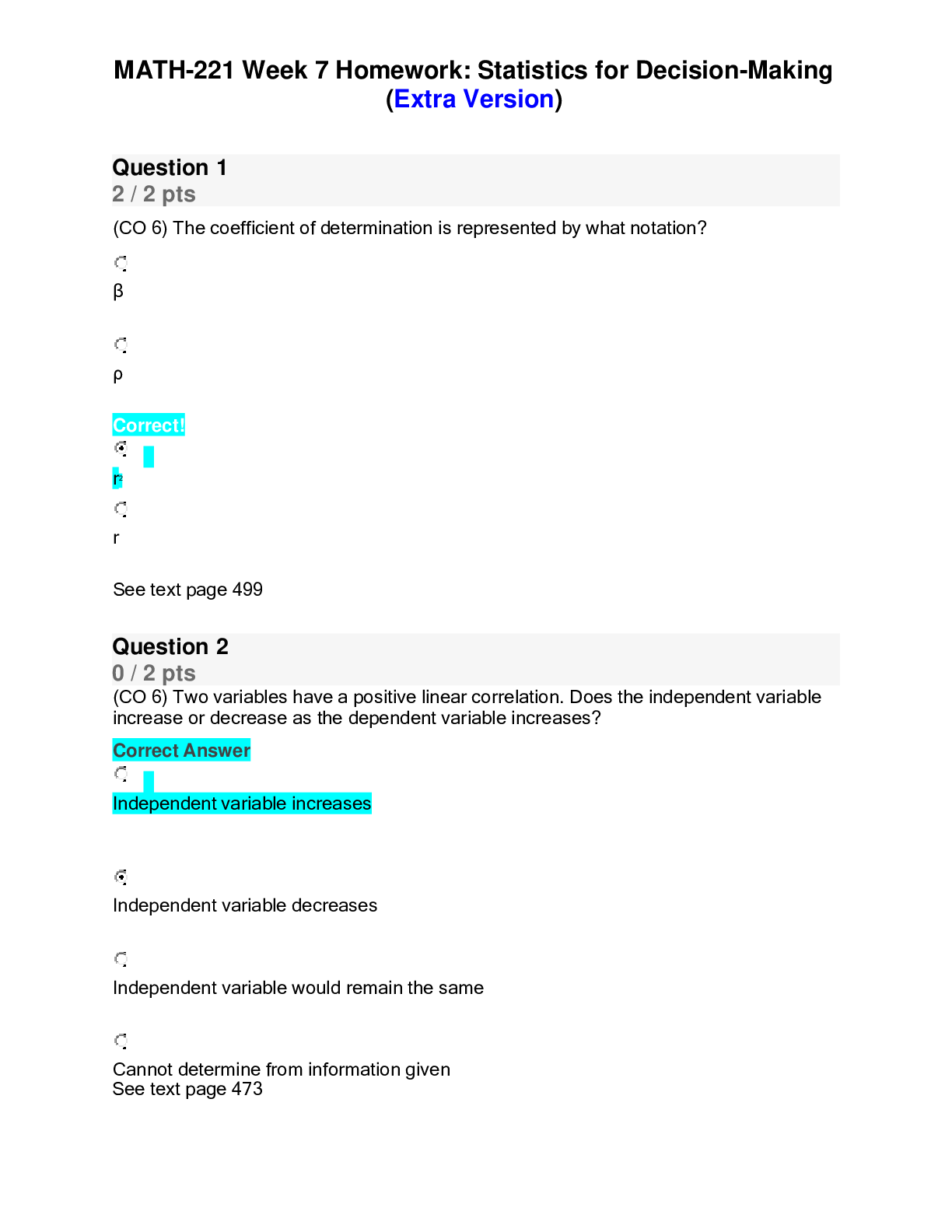


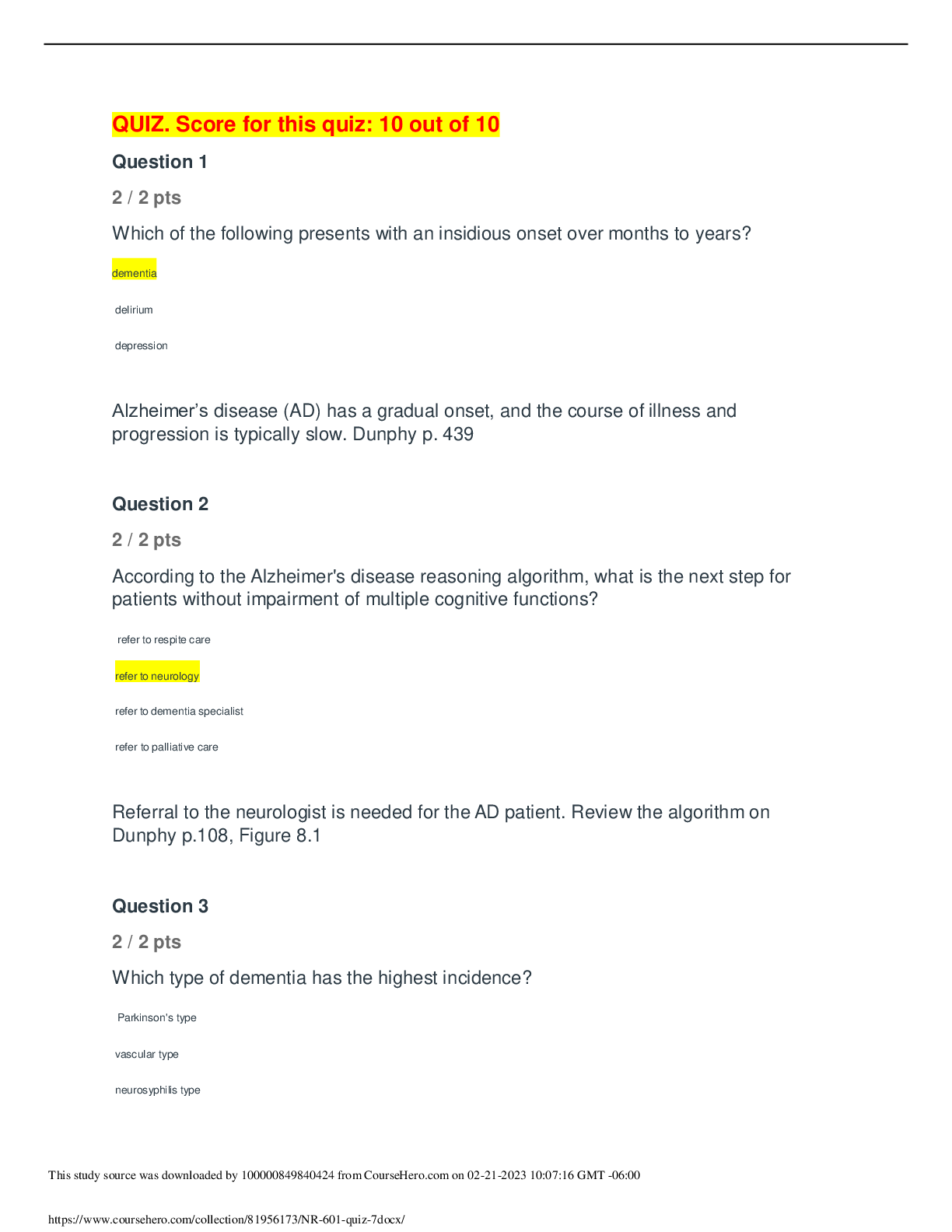
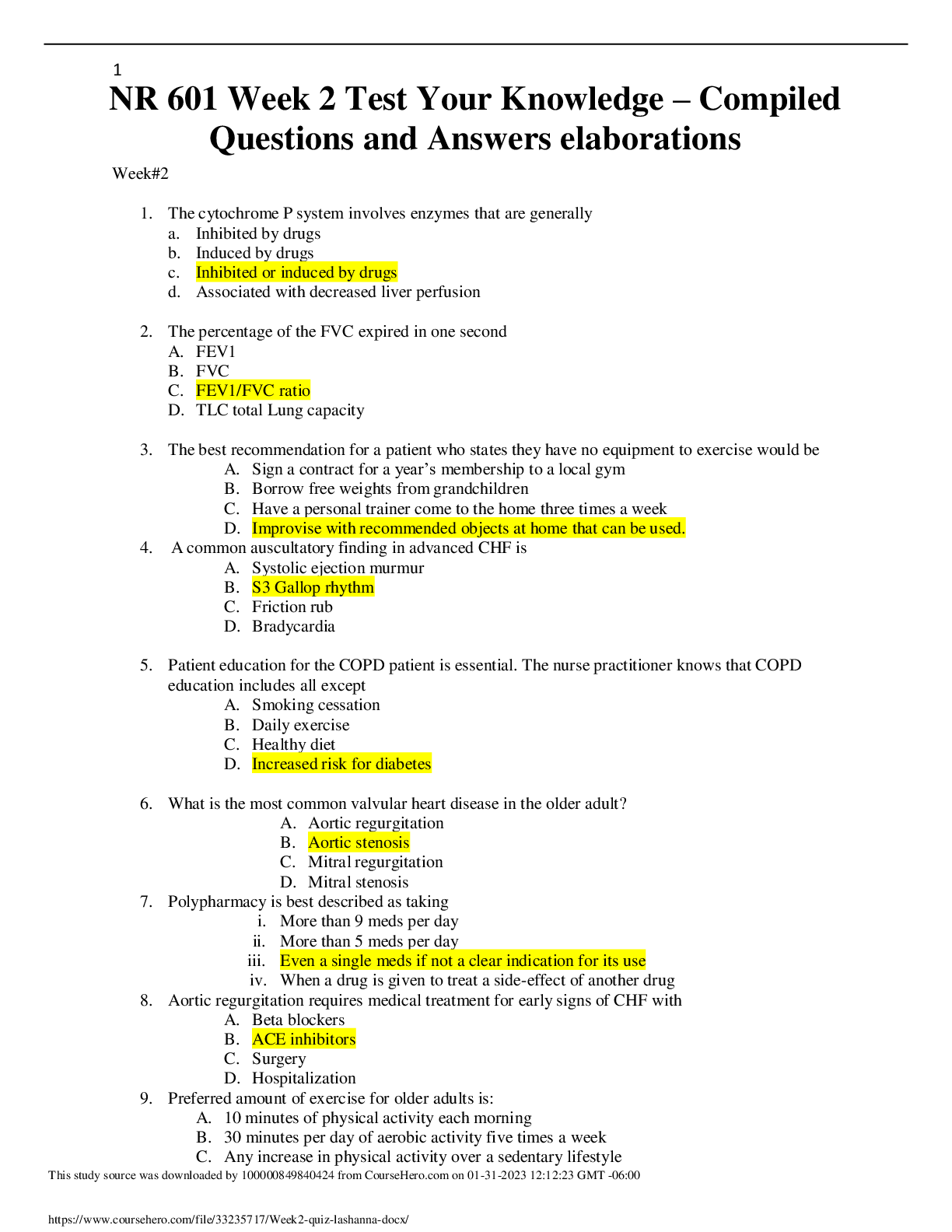
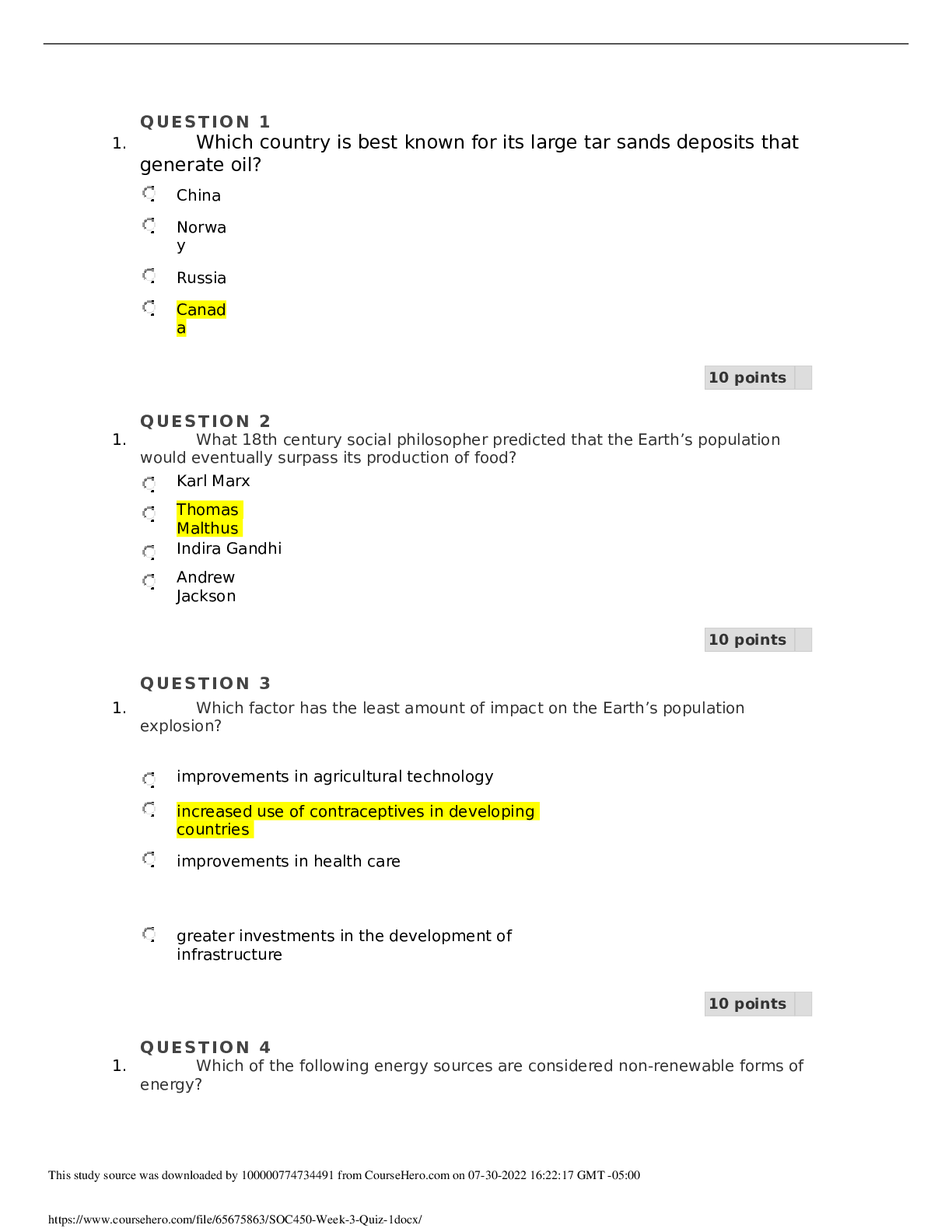
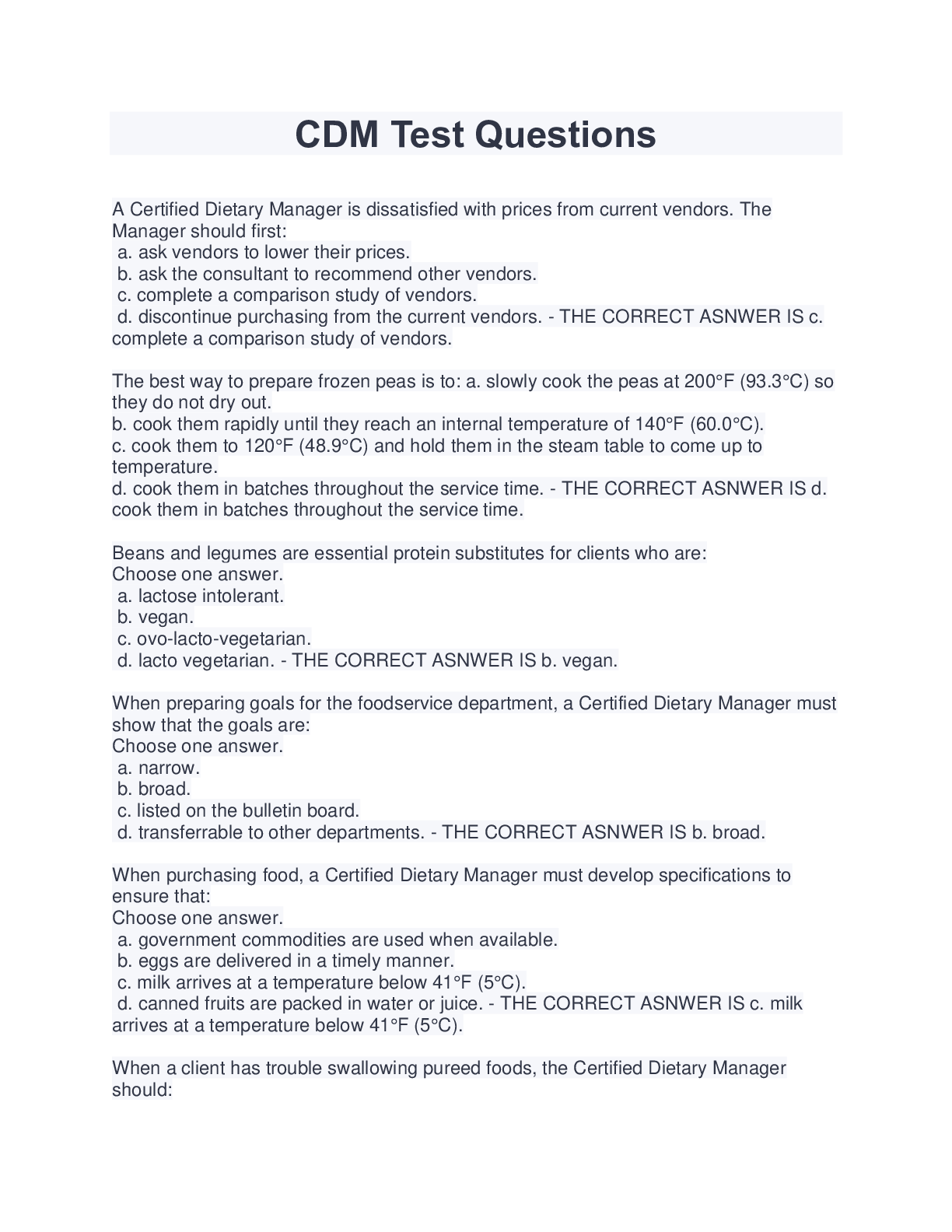
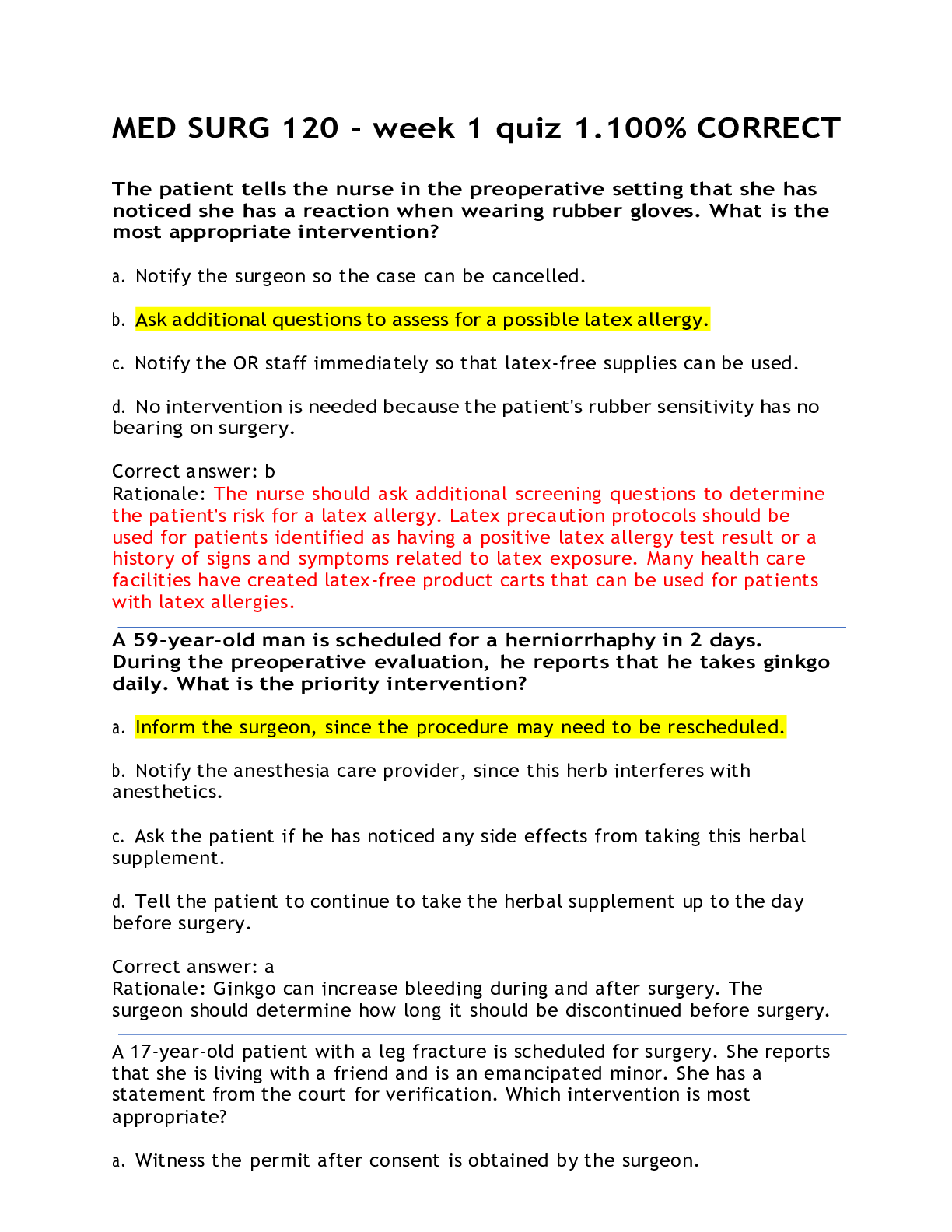



.png)


